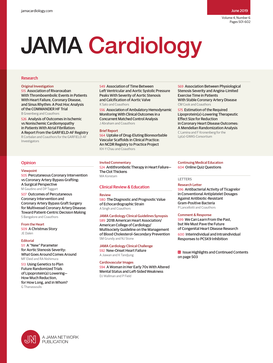高血压的药物依从性:一项随机临床试验。
IF 14.1
1区 医学
Q1 CARDIAC & CARDIOVASCULAR SYSTEMS
引用次数: 0
摘要
近一半的高血压患者存在药物不依从,但在临床护理中未得到充分认识。电子健康记录和药房之间的数据联系为在护理点对药物依从性进行可扩展的评估创造了机会。目的测试多组分干预的有效性,该干预通过使用关联的电子健康记录-药房数据结合基于团队的护理来识别未控制的高血压患者和药物不依从性,以解决依从性障碍。设计、环境和参与者steamlet(利用电子健康记录技术和团队护理来解决药物依从性)是一项实用的、双组、集群随机临床试验,于2022年10月至2024年11月在纽约的10个初级保健站点进行。该研究纳入了高血压不受控制且药物依从性低的成年人,定义为覆盖天数比例(PDC)小于80%。数据分析时间为2024年11月至2025年1月。干预措施包括以下内容:(1)在就诊时自动识别药物依从性不遵医嘱的患者;(2)促使医疗助理筛查阻碍依从性的因素;(3)临床决策支持,提醒初级保健医生和执业护士注意依从性障碍;(4)初级保健医师或执业护士与患者之间的依从性讨论。比较者通常受到照顾。主要结果和测量主要结果是PDC从基线到12个月的变化。结果1726例患者(平均[SD]年龄67.2[13.9]岁;887例(51.4%)女性),总体基线PDC均值(SD)为33.2%(30.5%)(干预组32.4%(30.4%),对照组34.0%(30.6%))。12个月时,干预组的SD PDC均值为51.1%(39.5%),对照组为53.1%(39.6%)。从基线到12个月,干预组和对照组的PDC变化没有差异(PDC的平均[SD]绝对变化分别为18.5[41.1]和18.2[40.9]个百分点;调整差值-0.15个百分点;95% CI, -4.06 ~ 3.76个百分点)。在12个月时收缩压的变化和患者的依从性(PDC≥80%)在两组之间也相似。结论和相关性在这项实用的试验中,将基于团队的初级保健与自动识别抗高血压药物不依从患者相结合的干预并没有导致依从性或血压的改善。临床试验注册号:NCT05349422。本文章由计算机程序翻译,如有差异,请以英文原文为准。
Medication Adherence in Hypertension: A Cluster Randomized Clinical Trial.
Importance
Medication nonadherence is present in nearly half of patients with hypertension but is underrecognized in clinical care. Data linkages between electronic health records and pharmacies have created opportunities for scalable assessment of medication adherence at the point of care.
Objective
To test the effectiveness of a multicomponent intervention that identified patients with uncontrolled hypertension and medication nonadherence using linked electronic health record-pharmacy data combined with team-based care to address adherence barriers.
Design, Setting, and Participants
TEAMLET (Leveraging Electronic Health Record Technology and Team Care to Address Medication Adherence) was a pragmatic, 2-arm, cluster randomized clinical trial conducted between October 2022 and November 2024 in 10 primary care sites in New York. The study included adults with uncontrolled hypertension and low medication adherence, defined as proportion of days covered (PDC) less than 80%. Data analysis was performed from November 2024 to January 2025.
Intervention
The intervention consisted of the following: (1) automated identification of patients with medication nonadherence at the time of the visit; (2) prompting of medical assistants to screen for barriers to adherence; (3) clinical decision support alerting the primary care physicians and nurse practitioners to barriers to adherence; and (4) adherence discussion between the primary care physician or nurse practitioner and the patient. The comparator was usual care.
Main Outcomes and Measures
The primary outcome was change in PDC from baseline to 12 months.
Results
Among 1726 patients (mean [SD] age, 67.2 [13.9] years; 887 [51.4%] female), the mean (SD) baseline PDC was 33.2% (30.5%) overall (32.4% [30.4%] in the intervention group and 34.0% [30.6%] in the control group). The mean (SD) PDC at 12 months was 51.1% (39.5%) for the intervention group and 53.1% (39.6%) for the control group. No difference was found in the change in PDC from baseline to 12 months between the intervention and control groups (mean [SD] absolute change in PDC, 18.5 [41.1] vs 18.2 [40.9] percentage points, respectively; adjusted difference, -0.15 percentage point; 95% CI, -4.06 to 3.76 percentage points). Change in systolic blood pressure and patients who became adherent (PDC ≥80%) at 12 months were also similar between groups.
Conclusions and Relevance
In this pragmatic trial, an intervention that combined team-based primary care with automated identification of patients with antihypertensive medication nonadherence did not lead to improvements in adherence or blood pressure.
Trial Registration
ClinicalTrials.gov Identifier: NCT05349422.
求助全文
通过发布文献求助,成功后即可免费获取论文全文。
去求助
来源期刊

JAMA cardiology
Medicine-Cardiology and Cardiovascular Medicine
CiteScore
45.80
自引率
1.70%
发文量
264
期刊介绍:
JAMA Cardiology, an international peer-reviewed journal, serves as the premier publication for clinical investigators, clinicians, and trainees in cardiovascular medicine worldwide. As a member of the JAMA Network, it aligns with a consortium of peer-reviewed general medical and specialty publications.
Published online weekly, every Wednesday, and in 12 print/online issues annually, JAMA Cardiology attracts over 4.3 million annual article views and downloads. Research articles become freely accessible online 12 months post-publication without any author fees. Moreover, the online version is readily accessible to institutions in developing countries through the World Health Organization's HINARI program.
Positioned at the intersection of clinical investigation, actionable clinical science, and clinical practice, JAMA Cardiology prioritizes traditional and evolving cardiovascular medicine, alongside evidence-based health policy. It places particular emphasis on health equity, especially when grounded in original science, as a top editorial priority.
 求助内容:
求助内容: 应助结果提醒方式:
应助结果提醒方式:


